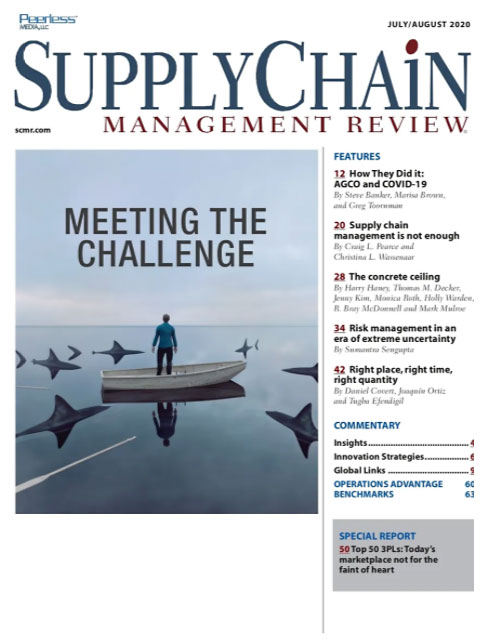Sorry, but your login has failed. Please recheck your login information and resubmit. If your subscription has expired, renew here.
July-August 2020
Supply chains have been in the news a lot the last couple of months, and not always for the right reasons. It seems as if the two words most often associated with supply chains these days are broken or failed, and supply chain is used to explain the shortages of everything from toilet paper to rib-eye steaks to personal protection equipment. Pundits question whether Amazon’s inability to make good on same-day and next-day deliveries or keep its endless shelves stocked during a pandemic will cost it market share. Browse this issue archive.Need Help? Contact customer service 847-559-7581 More options
The COVID-19 pandemic is disrupting global supply chains, with consequences for businesses, consumers and the global economy. Operations leaders are scrambling to respond to urgent questions about how to protect their employees, ensure supply security, mitigate the financial impact, address reputational risks and navigate market uncertainty. While many companies, institutions and governments have engaged in business continuity and risk management planning exercises in recent years, traditional risk management activities have largely centered on reacting to localized events pertaining to a specific geography or sector. The latest global supply disruptions underline the need for a new paradigm to develop supply chain resilience.
Even before the COVID-19 pandemic, supply chains were highly stressed. For decades, companies sought to aggressively optimize cost competitiveness through economies of scale, often by moving activities to lower-cost labor locations—frequently at the expense of other critical supply chain attributes like flexibility and agility. The most recent global supply chain supply continuity and cost challenges resulting from COVID-19, however, have laid bare many of the vulnerabilities and fragility brought about by this strategy and approach.
Kearney, in collaboration with the World Economic Forum, recently interviewed and surveyed more than 400 global operations and supply chain management C-suite executives on their responses to the COVID-19 crisis to deepen our insights on how they have been ensuring business continuity, protecting employees and implementing their strategies to succeed in the post-pandemic era. Forty-seven percent of those we surveyed indicated a need to overhaul their manufacturing and supply networks to increase future resilience and nearly two in five planned to place a greater focus on risk management going forward to become more flexible when it comes to reacting to future disruption. Figure 1 presents the top supply chain priorities for respondents coming out of the pandemic.
It seems clear that designing supply chain processes and outcomes around cost-competitiveness is no longer sufficient; companies will need to reorient toward approaches that embrace “risk-competitiveness” to ensure resilience moving forward. While there are many factors involved, achieving resilience will require that the next generation of supply chain winners move away from the traditional competitive advantages derived from economies of scale toward a greater emphasis on what we term “economies of skill.”

This complete article is available to subscribers only.
Log in now for full access or start your PLUS+ subscription for instant access.
SC
MR
Sorry, but your login has failed. Please recheck your login information and resubmit. If your subscription has expired, renew here.
July-August 2020
Supply chains have been in the news a lot the last couple of months, and not always for the right reasons. It seems as if the two words most often associated with supply chains these days are broken or failed, and… Browse this issue archive. Access your online digital edition. Download a PDF file of the July-August 2020 issue.The COVID-19 pandemic is disrupting global supply chains, with consequences for businesses, consumers and the global economy. Operations leaders are scrambling to respond to urgent questions about how to protect their employees, ensure supply security, mitigate the financial impact, address reputational risks and navigate market uncertainty. While many companies, institutions and governments have engaged in business continuity and risk management planning exercises in recent years, traditional risk management activities have largely centered on reacting to localized events pertaining to a specific geography or sector. The latest global supply disruptions underline the need for a new paradigm to develop supply chain resilience.
Even before the COVID-19 pandemic, supply chains were highly stressed. For decades, companies sought to aggressively optimize cost competitiveness through economies of scale, often by moving activities to lower-cost labor locations—frequently at the expense of other critical supply chain attributes like flexibility and agility. The most recent global supply chain supply continuity and cost challenges resulting from COVID-19, however, have laid bare many of the vulnerabilities and fragility brought about by this strategy and approach.
Kearney, in collaboration with the World Economic Forum, recently interviewed and surveyed more than 400 global operations and supply chain management C-suite executives on their responses to the COVID-19 crisis to deepen our insights on how they have been ensuring business continuity, protecting employees and implementing their strategies to succeed in the post-pandemic era. Forty-seven percent of those we surveyed indicated a need to overhaul their manufacturing and supply networks to increase future resilience and nearly two in five planned to place a greater focus on risk management going forward to become more flexible when it comes to reacting to future disruption. Figure 1 presents the top supply chain priorities for respondents coming out of the pandemic.
It seems clear that designing supply chain processes and outcomes around cost-competitiveness is no longer sufficient; companies will need to reorient toward approaches that embrace “risk-competitiveness” to ensure resilience moving forward. While there are many factors involved, achieving resilience will require that the next generation of supply chain winners move away from the traditional competitive advantages derived from economies of scale toward a greater emphasis on what we term “economies of skill.”
SC
MR


Latest Supply Chain News
- How CPG brands can deliver on supplier diversity promises
- How S&OP provides the answer to in-demand products
- AI, virtual reality is bringing experiential learning into the modern age
- Humanoid robots’ place in an intralogistics smart robot strategy
- Tips for CIOs to overcome technology talent acquisition troubles
- More News
Latest Podcast

 Explore
Explore
Business Management News
- How CPG brands can deliver on supplier diversity promises
- How S&OP provides the answer to in-demand products
- AI, virtual reality is bringing experiential learning into the modern age
- Tips for CIOs to overcome technology talent acquisition troubles
- There is still work to do to achieve supply chain stability
- Blooming success: The vital role of S&OE in nurturing global supply chains
- More Business Management
Latest Business Management Resources

Subscribe

Supply Chain Management Review delivers the best industry content.

Editors’ Picks






